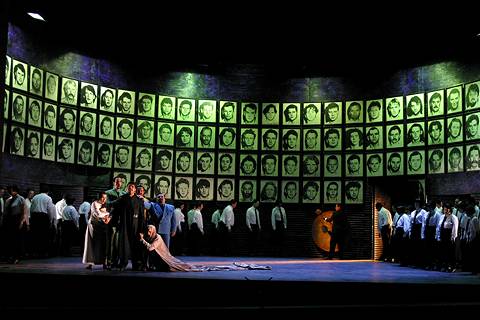|

Suspending disbelief?
'Turandot' at Welsh National Opera
reviewed by REX HARLEY
Turandot is an uncomfortable mix of fairy tale and reality, sentimentality and sadism. At least, it makes me uncomfortable, in the same way that the queasy morality of Wagner's world-view does. Sometimes the most beautiful music accompanies the most violent verbal imagery. Even a contemplation of the moon employs the language of torture. My other problem is with characters whose psychology, and resultant behaviour, simply baffles me. 'Just remember,' a friend said, as we climbed the stairs of Cardiff's New Theatre on 20 September 2004: 'Suspend disbelief.' It was my mantra for the evening.
The curtain rises to reveal a curved wall of corrugated iron, covered in large black-and-while 'mug shots' of all Turandot's previous victims: those infatuated men who have been foolish enough to risk their life in attempting to answer her three riddles. Succeed and they marry her; fail and they die -- painfully. And invariably they fail. These larger-than-life pictures dominate the First Act, and return to make their Point in Act III. The only problem is the way they constantly draw attention away from what is actually happening on stage.

Rafael Rojas (Calaf), Olga Mykytenko (Liù), Matthew Hargreaves (Ping), Philip Lloyd Holtam (Pang), Anthony Mee (Pong) and Ilya Bannik (Timur) in the Welsh National Opera production of 'Turandot'. Photo © 2004 Brian Tarr
|
In a sense, these photographs sum up both the strengths and weaknesses of this revival. The ideas, as the programme interview with original director Christopher Alden demonstrates, are imaginative and coherent, but the concept is not always either so clear or effective in practice.
Visually, Act II works best, in its exotic use of colour and lighting. In Scene One, Ping, Pang and Pong sit at their identical red desks, in their respectively green, yellow and blue suits, lamenting the changes in China since Turandot's rise to power, then snapping out of this reverie to become, once more, the faceless bureaucrats serving tyranny. Behind them hangs a massive banner in red and white, emblazoned with the legend: 'The riddles are three but death is one', Turandot's words which have effectively become the motto of a totalitarian state.
Continue >>
Copyright © 25 September 2004
Rex Harley, Cardiff UK

|

